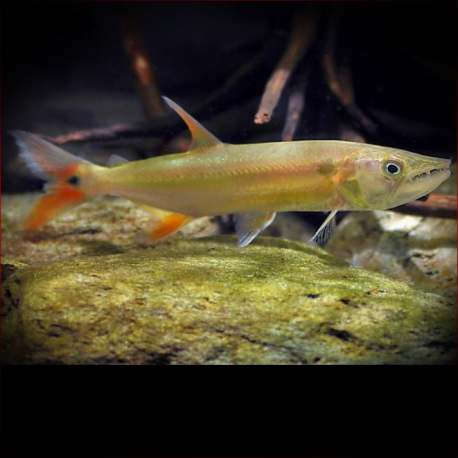More info
Datasheet
| Minimum Tank Size | 2000 litres / 528.34 US gallons |
| Maximum Size | 27.5cm / 10.83inches |
| Temperature | 22°C / 71.60°F - 28°C / 82.40°F |
| Hardness | 1.01dgH / 18ppm - 12.05dgH / 215ppm |
| pH | 6.0-7.5 |
General Description
The Red-Tailed Freshwater Barracuda, scientifically known as Acestrorhynchus Falcatus, is a predatory fish characterized by its appearance and behavior, often mistaken for a marine barracuda due to its name. It is part of the classification order Characiformes and belongs to the family Acestrorhynchidae. With a maximum size of 27.5cm, sexually mature females tend to be slightly larger and deeper-bodied compared to males. The species showcases distinguishable external features, with the most notable being the unique black humeral spot, which differentiates it from other Acestrorhynchus species.
Aquarium Setup
A minimum tank size of 2000 litres is recommended for the Red-Tailed Freshwater Barracuda. The setup should predominantly focus on open water, with minimal decorations to prevent stress. A sandy substrate, leaf litter, and driftwood can be used for a natural effect. Compatible plants such as Microsorum pteropus or Anubias spp. can be included. Adequate lighting based on plant requirements is crucial. A secure cover is necessary due to the fish's jumping tendency. Efficient filtration, preferably via external canister filters or a sump system, is essential to manage waste. Weekly water changes of 30-50% are vital to maintain water quality.
Behaviour
Known for its relative peacefulness with larger tank mates, the Red-Tailed Freshwater Barracuda should be kept in groups of four or more to prevent cannibalism within the species. They tend to school when young and become more solitary as they age. Pairing them with non-aggressive species like Geophagus spp. or Acarichthys heckelii is advised. The fish display territorial behavior; hence, it is crucial to avoid placing them with aggressive or competitive tank mates.
Feeding and Diet
As obligate piscivores, Red-Tailed Freshwater Barracudas primarily feed on live prey, but can be transitioned to accept dead or dried alternatives. Feeding them mammalian or avian meat should be avoided to prevent health issues. "Feeder" fish like livebearers are not recommended due to parasite and disease risks. Proper conditioning of prey is necessary to meet their nutritional needs.
Reproduction & Dimorphism
Although courtship and spawning have been observed in captivity, successful fry raising is rare. During mating, the male swims around the stationary female in a 'figure-of-eight' pattern, scattering eggs without parental care. Sexually mature females exhibit slightly larger and deeper-bodied features than males.
Habitat and Distribution
The Red-Tailed Freshwater Barracuda inhabits major river channels and tributaries, favoring clear and blackwater environments over turbid ones. Found across northern Amazon drainages in Peru and Brazil, as well as the Río Orinoco in Venezuela, they coexist with numerous other species. Some examples of sympatric species include Leporinus friderici, Aphyocharax alburnus, and Hyphessobrycon bentosi. Its distribution also extends to coastal river basins in Guyana, Suriname, and French Guiana.

